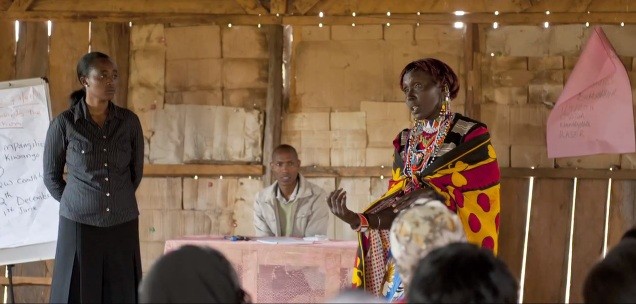
“Life has changed for my little girl Kayla,” says Gladys Chepkorir, a widow with two young daughters, “I have set up an account for her education, to give her more opportunities.”
Not so long ago, Gladys, who herself dropped out of school to have her first child at the age of 16, did not see the value in educating her daughters. In fact, within the community of Ol Posimuru, Kenya, convincing parents like Gladys to commit resources to educate girls was a huge challenge, recalls local Chief David Sang’are.
“Getting girls to attend school was really hard”, explains Alu Andrew Amadi, the Principal of Ol Pusimoru Secondary School, “always, the number of girls enrolling in this school has been less than 25% of the student body. When I arrived to be principal of this school, there were 19 girls enrolled and 70 boys”.
Where were all the teenage girls?
Married. And farming their husband’s land to provide food for their young children.
“But this year, for the first time, the number of girls is almost equal to the number of boys,” says a beaming Amadi. “This year, we admitted 26 girls out of an entering class of 55!”
Starting a dialogue on land rights and child marriage with tribal elders, women and youth
Indeed, things are rapidly changing since the country adopted a new constitution back in 2010. In a historic move, Kenya gave women unprecedented rights and protections, including the right to own and inherit land and share control over family resources.
It is in this critical window of opportunity that Landesa and USAID launched a pilot project to not only raise awareness of women’s land rights but also change behaviors towards them.
Landesa reached out to the community’s Kalenjin and Maasai tribal elders and local chiefs, women, youth, and teachers in intensive community conversations and workshops about the new constitution and the rights it affords women – particularly the right to access and manage family resources like land.
Before the project started, many community members didn’t know much about the new constitution and what little they had heard worried them. It seemed to go against their tribal culture and values.
However, the project’s months of workshops, discussions, and sometimes heated debates changed their views. They decided that the whole community would be better off if they worked to ensure that women and girls in their community actually benefited from the new constitution’s principles.
The power of women’s right to land for girls’ education
Women, eager to gain the skills they need to play a larger role in their home and community, as well as to advocate for themselves, joined in public speaking training. For the first time in centuries, a woman was elected to the council of tribal elders!
Women’s new roles as tribal elders, landowners, and managers of family resources, have drawn attention to the need for equal education for girls.
“Parents now are more supportive of girls’ education. They believe that girls too can play a role in society”, explains Principal Amadi. “Previously, parents would not want to spend their money investing in a girl. It is like a waste of resources.”
Mary is a farmer and a mother of 11. Her husband sold their lands without consulting her and would not support their children’s education. She had to lease her neighbours’ lands to cultivate and provide for her kids.
Landesa’s training has changed her life: “The greatest change is that my husband has given me what I wanted most: land. Now I can take care of my children”.
When women gain joint control over their family’s land, they gain a powerful resource they can use to not only feed their children, but also generate income. And with equal control over those funds, women are earmarking family resources to pay school fees for all their children – girls included.
Since Landesa’s project, Gladys sees her daughter’s future in a new light: she will be a student, not a bride. Gladys wraps her arm around her dimpled 10-year-old, “She now has a better a chance in life”.
To learn more about Landesa’s work in Kenya, watch our film, “Elders Speak: A New Dawn for Women in Kenya“.
This blog post originally appeared on GirlsNotBrides.org
